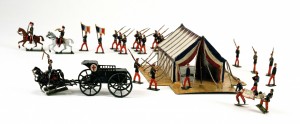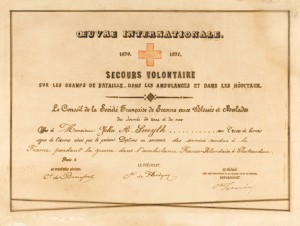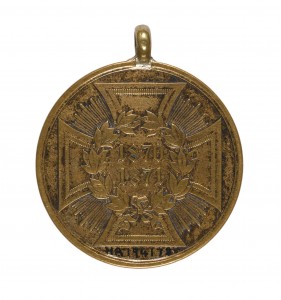The Ambulance Irlandais in the Franco-Prussian War
Published in Artefacts, Issue 5 (September/October), Volume 22
French toy soldiers brought back by Col. J. O’Scanlon. (NMI)
When the Franco-Prussian War (August 1870–February 1871) broke out, the UK (then including Ireland) was officially neutral. Count Otto von Bismarck, chancellor of Prussia, had goaded France into declaring war on 15 July 1870; two months later the French army, led by Marshall MacMahon (whose family came from County Limerick), and Emperor Napoleon surrendered after the Battle of Sedan. The Second Empire ended and the Third Republic was proclaimed; fighting continued until January 1871, when the French were again defeated.

War certificate of service and Franco-Prussian War medal (above) of J.A. Smyth. (NMI)
In Ireland there were many who remembered romantically the Wild Geese of the seventeenth and eighteenth centuries and, more recently, the Papal Brigade, who had gone to Italy in 1860 to defend the Papal States from Italian nationalists. In response, the British government had banned recruiting in Ireland for foreign armies. Therefore a volunteer committee decided to send an Irish field ambulance corps to France.
The corps—31 surgeons, 250 men, five wagons, tents and bedding—paraded for the first time at the Rotunda gardens in Dublin on 8 October 1870. They then sailed to France, arriving on 11 October and serving until February 1871. The corps was split into two parts, fighting with the new Republican armies of the North and the Loire. The volunteers collected wounded soldiers from the battlefields and returned them to the Irish casualty station, where doctors treated their wounds and operated if necessary. Military medicine had not developed much since the Battle of Waterloo in 1815; leeches were still used and most of the surviving corps reports covering their four months in France show a high number of amputations.

The winter of 1870 was very cold in Europe, and this stopped the outbreak of diseases normally associated with armies—smallpox, typhoid and dysentery. Nevertheless, the one Irish casualty was a wagon-driver, William Hopkins, who died of smallpox in November. During the war some of the Irish volunteers decided that they wanted to fight and transferred to the Irish company of the French Foreign Legion led by Myles Waters Kirwan. New volunteers joined the corps, including J.J. O’Scanlon, an Irish merchant based in Le Havre, whose family donated his collection of memorabilia to the National Museum in the 1930s.
Lar Joye is curator of military history at the National Museum of Ireland (Decorative Arts).
















